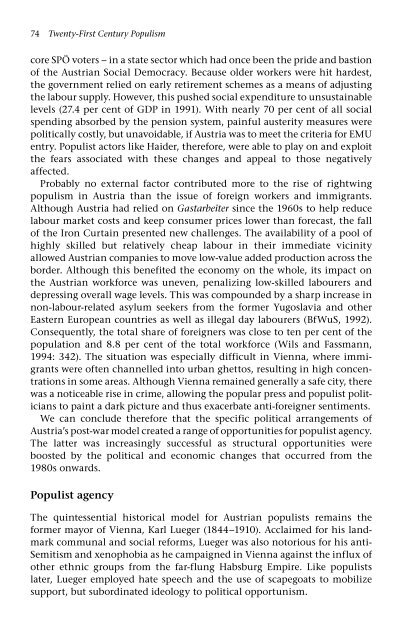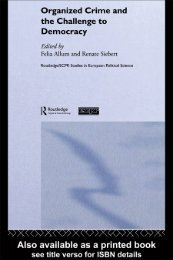Twenty-First Century Populism: The Spectre of Western European ...
Twenty-First Century Populism: The Spectre of Western European ...
Twenty-First Century Populism: The Spectre of Western European ...
You also want an ePaper? Increase the reach of your titles
YUMPU automatically turns print PDFs into web optimized ePapers that Google loves.
74 <strong>Twenty</strong>-<strong>First</strong> <strong>Century</strong> <strong>Populism</strong><br />
core SPÖ voters − in a state sector which had once been the pride and bastion<br />
<strong>of</strong> the Austrian Social Democracy. Because older workers were hit hardest,<br />
the government relied on early retirement schemes as a means <strong>of</strong> adjusting<br />
the labour supply. However, this pushed social expenditure to unsustainable<br />
levels (27.4 per cent <strong>of</strong> GDP in 1991). With nearly 70 per cent <strong>of</strong> all social<br />
spending absorbed by the pension system, painful austerity measures were<br />
politically costly, but unavoidable, if Austria was to meet the criteria for EMU<br />
entry. Populist actors like Haider, therefore, were able to play on and exploit<br />
the fears associated with these changes and appeal to those negatively<br />
affected.<br />
Probably no external factor contributed more to the rise <strong>of</strong> rightwing<br />
popu lism in Austria than the issue <strong>of</strong> foreign workers and immigrants.<br />
Although Austria had relied on Gastarbeiter since the 1960s to help reduce<br />
labour market costs and keep consumer prices lower than forecast, the fall<br />
<strong>of</strong> the Iron Curtain presented new challenges. <strong>The</strong> availability <strong>of</strong> a pool <strong>of</strong><br />
highly skilled but relatively cheap labour in their immediate vicinity<br />
allowed Austrian companies to move low-value added production across the<br />
border. Although this benefited the economy on the whole, its impact on<br />
the Austrian workforce was uneven, penalizing low-skilled labourers and<br />
depressing overall wage levels. This was compounded by a sharp increase in<br />
non-labour-related asylum seekers from the former Yugoslavia and other<br />
Eastern <strong>European</strong> countries as well as illegal day labourers (BfWuS, 1992).<br />
Consequently, the total share <strong>of</strong> foreigners was close to ten per cent <strong>of</strong> the<br />
population and 8.8 per cent <strong>of</strong> the total workforce (Wils and Fassmann,<br />
1994: 342). <strong>The</strong> situation was especially difficult in Vienna, where immigrants<br />
were <strong>of</strong>ten channelled into urban ghettos, resulting in high concentrations<br />
in some areas. Although Vienna remained generally a safe city, there<br />
was a noticeable rise in crime, allowing the popular press and populist politicians<br />
to paint a dark picture and thus exacerbate anti-foreigner sentiments.<br />
We can conclude therefore that the specific political arrangements <strong>of</strong><br />
Austria’s post-war model created a range <strong>of</strong> opportunities for populist agency.<br />
<strong>The</strong> latter was increasingly successful as structural opportunities were<br />
boosted by the political and economic changes that occurred from the<br />
1980s onwards.<br />
Populist agency<br />
<strong>The</strong> quintessential historical model for Austrian populists remains the<br />
former mayor <strong>of</strong> Vienna, Karl Lueger (1844−1910). Acclaimed for his landmark<br />
communal and social reforms, Lueger was also notorious for his anti-<br />
Semitism and xenophobia as he campaigned in Vienna against the influx <strong>of</strong><br />
other ethnic groups from the far-flung Habsburg Empire. Like populists<br />
later, Lueger employed hate speech and the use <strong>of</strong> scapegoats to mobilize<br />
support, but subordinated ideology to political opportunism.



